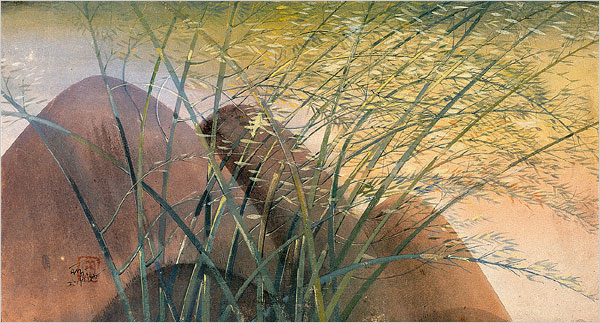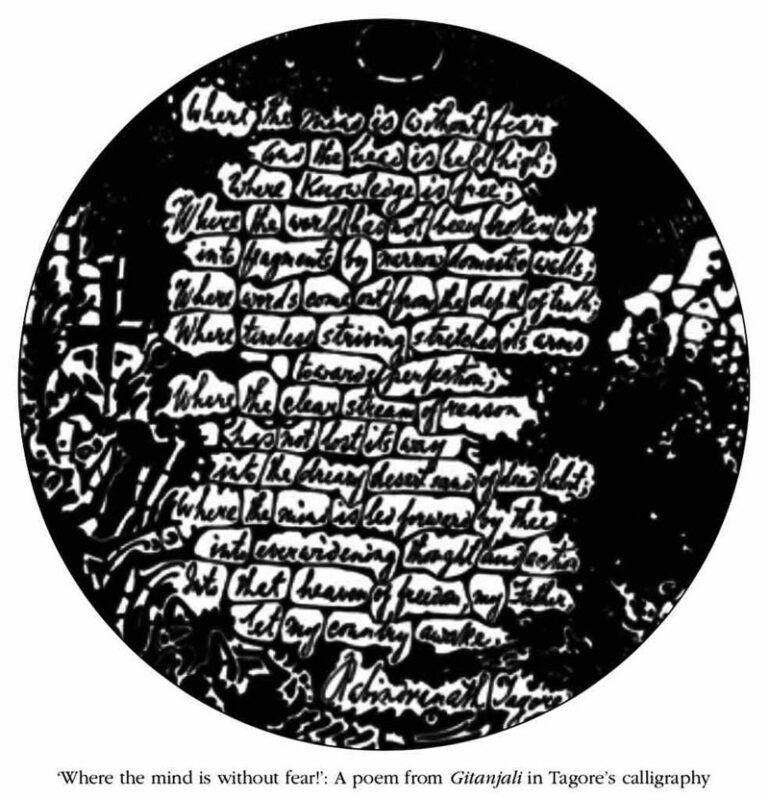
(cement and laterite gravel) at Santiniketan >>
Photo © Ludwig Pesch | Santal customs >>
UNESCO World Heritage Centre >>
One of India’s foremost modernist sculptors, Ramkinkar Baij is remembered as the ‘eccentric genius’ from Bankura who was ahead of his times. The pioneering artist experimented both with material and subjects to create works in multiple mediums and give India some of its most monumental sculptures that have become landmarks in public art. […]
Several of Baij’s students often narrate how when he’d present William Shakespeare’s plays in the Kala Bhavan campus, and the audience often comprised local Santhal villagers who would be enthralled by the sheer energy of the productions. Hailing from the red-soiled land of West Bengal, Baij, who grew up observing the local clay idol makers of Bankura, shared a deep relationship with the communities around him, including the Santhals who lived near Santiniketan. Considered to be probably India’s first public modernist sculpture, Santhal Family, in cement and laterite gravel, was also Baij’s tribute to their resolve to fight against odds. Done in 1938, it represented the dynamism of traditional Bengal at the time of industrialisation. The rhythmic movement is unmissable, as the protagonists — a couple with their children and a dog — march ahead with a weighing scale. Years later, in 1956, he executed Mill Call, another significant work that celebrated the working class and the Santhals, depicting women rushing at the sound of the siren from a mill.
Source: “Five landmark works by India’s foremost sculptor Ramkinkar Baij by Vandana Kalra, Indian Express, 30 May 2020
URL: https://indianexpress.com/article/lifestyle/art-and-culture/five-landmark-works-by-india-foremost-sculptor-ramkinkar-baij-6434287/
Date visited: 1 May 2021
Ramkinkar Baij’s rebellion was against himself, he renewed himself constantly […] Baij, as famous for his reticence as for his single-minded devotion to art, will be remembered through an exhibition of 500 paintings, his sketch-books and sculptures apart from photographs of his works in Shantiniketan in West Bengal. The exhibition, to be held at the National Gallery of Modern Art in Delhi from February 8 to March 31, will be accompanied by six book releases.
Born in Bankura, West Bengal in 1906, Baij’s best-known work is a sculpture called Santhal Family (1938), in which he represents tribal peasants with the grace and dignity that, thus far, had been reserved for gods and rulers in the world of art.
Source: Santhal Warrior – Indian Express
Address : http://www.indianexpress.com/news/santhal-warrior/908307/
Date Visited: Sat Feb 18 2012 10:29:17 GMT+0100 (CET)
In July 1975 Ghatak commenced shooting on the sculptor at Shantiniketan for a stretch of four days. The movie is a biographical (personality study) film where Baij has been featured as a political icon too. In the film, Ramkinkar Baij speaks about the problems that he faces in his life. […]
At Santiniketan, under the guidance of Nandalal Bose and encouraged by its liberating intellectual environment, shaped by Rabindranath Tagore, his artistic skills and intellectual horizons acquired new depth and complexity. […] While Baij was making a portrait of Tagore, during one sitting, the old poet advised him to approach the subject as a tiger and through the observation suck into its blood. After this, in Baij’s own words, he “did not look back”.
Source: “Ramkinkar Baij A Personality Study Documentary by Ritwik Ghatak YouTube”
URL: https://youtu.be/GCBWrdN1eRY
Date visited: 28 April 2021

surrounding Santiniketan | UNESCO World Heritage Centre >>
“At Santiniketan, art was to be an integral part of an all-rounded education.” – Partha Mitter in The triumph of modernism: India’s artists and the avant-garde, 1922-1947 >>
When he arrived at Santiniketan, he was at the zenith of his career and both Nandalal Bose and Rabindranath Tagore realised that Ramkinkar perhaps needed no training. The Santhals, the arid Khoai, the open sky combined with the tremendous freedom that the institution Kala Bhavan offered him at Santiniketan as a teacher and student, brought to the fore his creative best. Baij, in his frenzied quest to develop a new modern language in painting and sculpture, invested spontaneity, vitality and dynamism in his works, which stand unique till date.
His works talk about people, places and things as he focuses on rural treasures and the stocky and robust Santhals, the original inhabitants of the land. He talks about a society free from technological invasion and one where Nature dominates the pulse of life. We get to see wallowing buffaloes in mud-pools, harvesters threshing corn with an easy charm, or a Santhal family relaxing on a cot, in his watercolours. Every nook and corner of Santiniketan provided him subjects of pastoral innocence, evoking in us a strong sense of belonging that the artist had.
Source: The Hindu : FEATURES / FRIDAY REVIEW : Baij, the unsung hero
Address : https://www.thehindu.com/todays-paper/tp-features/tp-fridayreview/article1046559.ece
Date Visited: 30 September 2020
[Bold typeface added above for emphasis]
India Perspectives (24 No. 2/2010) | More about Tagore and rural education >>
Source: “Tagore, Gitanjali and the Nobel Prize” by Nilanjan Banerjee in

Freedom: Accountability, Childrens right to education, Democracy & Rights of Indigenous Peoples >>
To locate the Museum of Santal Culture in Bishnubati village (near Santiniketan) on the map seen below, open by clicking on the left button:
Tips for using interactive maps
Toggle to normal view (from reader view) should the interactive map not be displayed by your tablet, smartphone or pc browser
For details and hyperlinks click on the rectangular button (left on the map’s header)
Scroll and click on one of the markers for information of special interest
Explore India’s tribal cultural heritage with the help of another interactive map >>